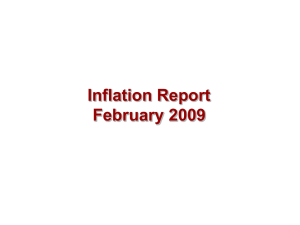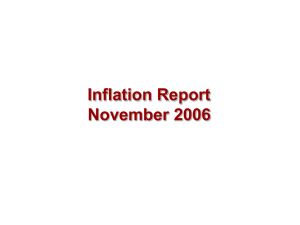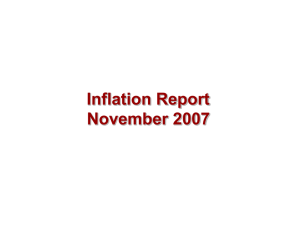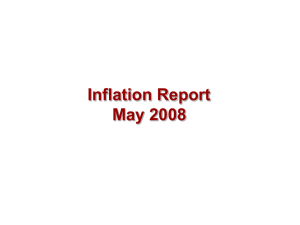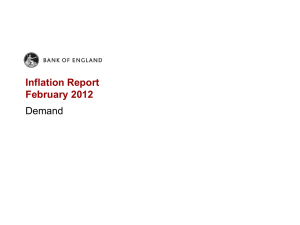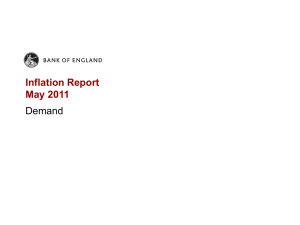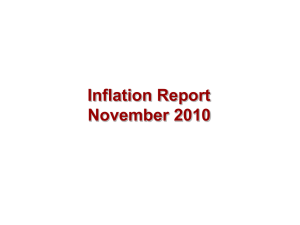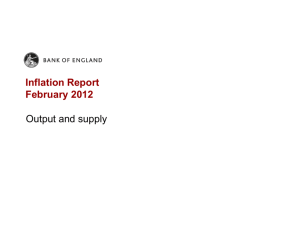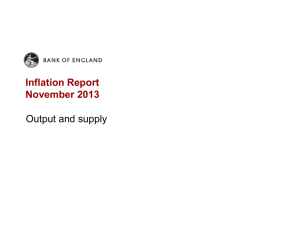Inflation Report February 2006
advertisement
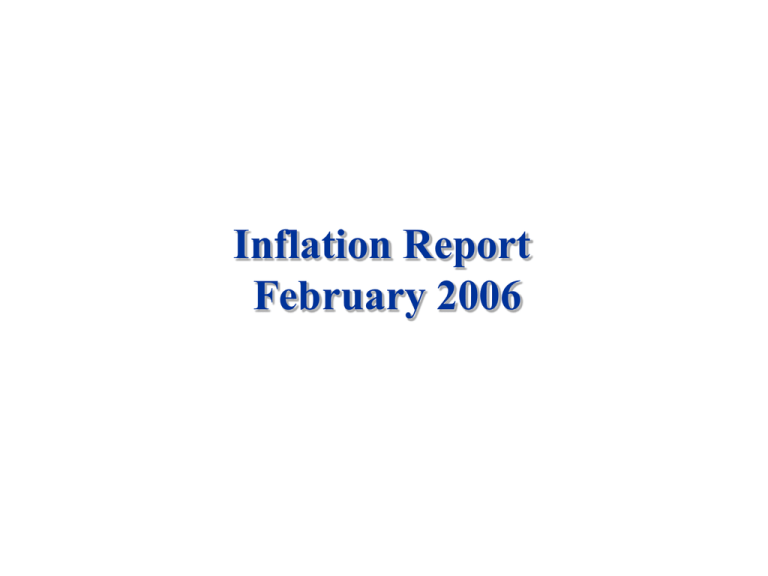
Inflation Report February 2006 Output and supply Chart 3.1 Whole-economy output(a) (a) Chained-volume measure of gross value added at basic prices. 2005 Q4 data were unavailable at the time of the November Report. Chart 3.2 Service sector output(a) (a) Chained-volume measure. 2005 Q4 data were unavailable at the time of the November Report. Chart 3.3 Employment(a) (a) Data are from the LFS and are for non-overlapping quarters ending in February, May, August and November each year. (b) Data have been divided by four to allow them to be compared with the quarter-on-quarter series. Chart 3.4 Whole-economy and private sector productivity (a) Productivity is calculated on a per head basis using LFS employment data. The figure for 2005 Q4 is based on employment data for September to November 2005. (b) Productivity is calculated on a per head basis using LFS employment data and ONS public sector employment data. Chart 3.5 Average hours worked(a) (a) Data are from the LFS and are for actual hours worked. The shaded area is the period from 2004 Q3, when four-quarter output growth began to slow markedly. 2005 Q4 data are for September to November 2005. Chart 3.6 Agents’ survey:(a) the importance of migrants in sectoral employment (a) Based on 225 responses from a survey of companies by the Bank of England’s regional Agents in November 2005, weighted by respondents’ number of employees. (b) Percentage of firms in which non-UK nationals accounted for 10% or more of the workforce. (c) Includes other consumer services. Chart 3.7 Sectoral basic pay and overtime pay in 2005(a) Source: Annual Survey of Hours and Earnings. For further details on these data, see www.statistics.gov.uk/StatBase/Product.asp?vlnk=14203. (a) Median. (b) Includes pay before deductions for PAYE, National Insurance, pension schemes and voluntary deductions, but excludes overtime, shift premium and bonus or incentive pay. Chart 3.8 Unemployment rate (a) Three-month moving average. This measure includes all those actively looking for work and available to start, and those due to start a new job in the next two weeks. Tables Table 3.A Activity measures(a) Percentage changes on a quarter earlier 2003 Average Whole-economy output Private sector output(b) 0.8 0.8 2004 Q1 Q2 Q3 0.8 0.8 0.3 0.2 0.8 1.0 Q4 2005 Q1 Q2 Q3 Q4 0.6 0.6 0.3 0.1 0.4 0.4 0.6 0.6 0.5 0.5 (a) Chained -volume measures of gross value added at basic prices. (b) Private sector output is calculated by excluding public administration, national defence and social security, health and social work, and education from the average measure of gross value added. The figure for 2005 Q4 was estimated using information in the preliminary GDP release. Table 3.B Manufacturing output Average(a) 2005 Q1 Q2 Q3 Q4 2006 Jan. Surveys CIPS/RBS output index(b) CBI past output trends balance(c) CBI output expectations balance(c) 53.3 0 7 52.6 -10 5 49.8 -1 6 52.6 -13 2 53.5 -6 1 53.8 n.a. n.a. Percentage change on a quarter earlier ONS manufacturing output 0.1 -0.9 -0.4 0.3 -1.0 n.a. Sources: CBI, CIPS/RBS and ONS . (a) The CIPS/RBS average is calculated from July 1991. The averages for the CBI balances and for manufacturing output growth are calculated from 1975 Q1. (b) Quarterly data refer to the average of the three CIPS/RBS monthly balances. An index above/below 50 implies rising/falling output. (c) Data are non seasonally adjusted. Table 3.C Factor utilisation(a) Average(b) 2004 Q4 2005 Q1 Q2 Q3 Q4 2006 Jan. Manufacturing CBI(c) BCC(d)(e) Agents(f) 40 36 -0.8 41 40 0.8 39 38 0.0 45 38 0.0 39 35 -0.6 38 35 -1.1 n.a. n.a. -1.0 Services BCC(d) Agents(f) 39 1.3 44 1.7 38 1.9 36 2.1 35 1.8 39 1.3 n.a. 1.4 Sources: Bank of England, BCC and CBI. (a) All data are non seasonally adjusted. (b) 1995–2004 for the BCC and CBI surveys. The averages for the Agents’ scores are calculated from January 1998 to December 2004. Historical averages of survey balances can be used to gauge whether the economy is approaching ‘normal’ levels of factor utilisation. Different time periods though can give different impressions of what is ‘normal’. See the box on pages 24–25 of the February 2005 Report. (c) Weighted percentage of respondents not ‘working below a satisfactory full rate of operation’. (d) Percentage of firms working at full capacity. (e) Also includes agriculture, energy and construction. (f) See Ellis, C and Pike, T (2005), ‘Introducing the Agents’ scores’, Bank of England Quarterly Bulletin, Winter, pages 424–30. Quarterly data refer to the average of the three monthly Agents’ scores. Table 3.D Survey evidence on recruitment difficulties and labour shortages 2004 Q4 2005 Q1 Q2 Q3 Q4 2006 Jan. Availability of agency staff (a) Deloitte/REC: Permanent staff 38.9 Deloitte/REC: Temporary staff 43.7 42.8 46.4 46.0 49.1 48.0 50.6 45.1 48.8 46.5 50.6 Factors likely to limit output(b) CBI: Skilled labour CBI: Other labour 11 3 11 3 16 4 10 2 n.a. n.a. 14 2 Sources: CBI and Deloitte/REC Report on Jobs. (a) Indices, for which 50 represents no change. Quarterly data refer to the average of the three monthly balances. (b) Data are for the manufacturing sector and are percentages (weighted by respondents). The data are non seasonally adjusted.
